Exploring Trends in Innovation within Digital Economy Research: A Scientometric Analysis
Abstract
:1. Introduction
- What are the most relevant keywords related to innovation in digital economy research?
- What are the most influential journals and prolific authors in innovation and digital economy studies?
- What are the most prevalent topics of innovation in the digital economy among scholars?
- What are upcoming publication trends regarding studies on innovation in the digital economy?
2. Methodology
- Power (π) = P (rejecting h0|h0 is false). We set the power at 0.8 and 0.9, which means that we wanted a sample size that is large enough that we will correctly reject the null 80% and 90% of the time when it is false. A bigger value can be used if more power is thought to be required, but doing so will also call for a larger sample size.
- Alpha (α) = P (rejecting h0|h0 is true). We set α = 0.05 (medium) and 0.01 (low), which are commonly used criteria for rejection. The differences between null and alternative hypotheses must be large enough that we would expect to only reject the null 5% and 1% of the time when the null is true.
- Effect Size (ρ): The smaller the sample size required to yield statistically significant effects, the higher the effect size. We set ρ = 0.1 (small), 0.3 (medium), and 0.5 (large) based on G*Power ver. 3.1.9.7.
- N is the required sample size given the values for α, effect size, and π that have been established. In this instance, the researcher has stated the other variables, and N is an estimate.
3. Results
3.1. Descriptive and Trend Analysis
3.2. Source Analysis
3.3. Author Analysis
3.4. Document Analysis
3.5. Conceptual Structure
- Number of Words (250): This parameter specifies the maximum number of words to consider when identifying and analyzing research themes. In this case, the analysis focused on 250 words per theme.
- Min Cluster Frequency (per thousand docs) (5): This parameter sets a minimum threshold for the frequency of a theme within the corpus. Themes that appeared at least five times per thousand documents were considered relevant for inclusion in the map.
- Number of Labels (5): The number of labels represents the limit on the number of key themes explicitly labeled and presented in the map. In this study, up to five key themes were labeled.
- Label Size (0.3): Label size determines the font size or prominence of the labels associated with themes. A label size of 0.3 suggests that the labels for key themes are presented in a moderately prominent manner.
- Community Repulsion (0): Community repulsion is a parameter used to control the spatial separation of themes in the map. A value of 0 indicates that articles are not repelled from each other, potentially leading to closer clustering of related articles.
- Clustering Algorithm (Fast Greedy): The choice of the clustering algorithm is crucial for identifying related themes. The “Fast Greedy” algorithm is used for network community detection. It helps identify closely associated themes and group them into clusters.
3.6. Intellectual Structure
3.7. Social Structure
4. Discussion
5. Conclusions
Author Contributions
Funding
Institutional Review Board Statement
Informed Consent Statement
Data Availability Statement
Conflicts of Interest
Appendix A
| Cluster | Ref. | Title | Year | Author Keywords |
|---|---|---|---|---|
| Red | (Ma and Zhu 2022) | Innovation in emerging economies: Research on the digital economy driving high-quality green development | 2022 | Digital economy High-quality green development Smart city Spillover effects |
| (Goldfarb and Tucker 2019) | Digital economics | 2019 | - | |
| (Nunn and Qian 2014) | US food aid and civil conflict | 2014 | - | |
| (Cao et al. 2021) | Digital finance, green technological innovation, and energy-environmental performance: Evidence from China’s regional economies | 2021 | Digital finance Green technological innovation Energy-environmental performance Difference-in-difference model China | |
| (Zhang et al. 2022c) | Digital economy and carbon emission performance: Evidence at China’s city level | 2022 | Digital economy Carbon emission performance Mediating effect Nonlinear effect Spatial spillover effect | |
| (Li et al. 2021a) | Energy structure, digital economy, and carbon emissions: Evidence from China | 2021 | Energy structure Digital economy Carbon emissions Resource-based province | |
| (Li et al. 2021b) | Digital economy and environmental quality: Evidence from 217 cities in China | 2021 | Digital economy Environment Coupling Coordination Threshold Effect PM2.5 | |
| (Nambisan et al. 2019) | The digital transformation of innovation and entrepreneurship: Progress, challenges and key themes | 2019 | Digital transformation Innovation Entrepreneurship Digital innovation Digital platforms Openness Generativity Affordance | |
| (Wu et al. 2021a) | How does internet development affect energy-saving and emission reduction? Evidence from China | 2021 | Internet development Energy saving and emission reduction efficiency Threshold model Spatial Durbin model IV estimation DID | |
| (Ding et al. 2022) | Digital Economy, Technological Innovation and High-Quality Economic Development: Based on Spatial Effect and Mediation Effect. | 2022 | Digital economy Green total factor productivity Industrial structure | |
| (Beck et al. 2010) | Big bad banks? The winners and losers from bank deregulation in the United States | 2010 | - | |
| (Chen 2020) | Improving market performance in the digital economy | 2020 | Digital economy Digitization platforms Search innovation Data protection Privacy | |
| Blue | (Tapscott 2016) | The digital economy: Promise and peril in the age of networked intelligence | 1996 | - |
| (Li and Wang 2022) | The dynamic impact of digital economy on carbon emission reduction: Evidence city-level empirical data in China | 2022 | Digital economy Carbon emission reduction Spatial spillover effect SDM | |
| (Ma et al. 2022) | The nexus between digital economy and carbon dioxide emissions in China: The moderating role of investments in research and development | 2022 | Carbon emission Digital economy Research and development Technological innovation Carbon-neutrality China | |
| (Wu et al. 2021b) | Does internet development improve green total factor energy efficiency? Evidence from China | 2021 | Internet development Green total factor energy efficiency Spatial Durbin model Dynamic threshold model | |
| (Pan et al. 2022) | Digital economy: An innovation driver for total factor productivity | 2022 | Digital economy Total factor productivity Principal component analysis Nonlinear relationship Regional diversity | |
| (Su et al. 2021) | Does the digital economy promote industrial structural upgrading? A test of mediating effects based on heterogeneous technological innovation | 2021 | Digital economy Industrial structure upgrading Technological innovation Mediating effect | |
| (Acemoglu and Restrepo 2018) | The race between man and machine: Implications of technology for growth, factor shares, and employment | 2018 | - | |
| (Zhang et al. 2022a) | Digital economy: An innovation driving factor for low-carbon development | 2022 | Digital economy Low-carbon development Intermediary effect model | |
| (Yi et al. 2022) | Effects of digital economy on carbon emission reduction: New evidence from China | 2022 | Digital economy Carbon emission reduction Energy structure Spatial spillover effect Regional heterogeneity | |
| (Li et al. 2022) | Innovation and Optimization Logic of Grassroots Digital Governance in China under Digital Empowerment and Digital Sustainability | 2022 | Digital economy Carbon emissions Logistics industry | |
| (Ren et al. 2021) | Digitalization and energy: How does internet development affect China’s energy consumption? | 2021 | Digitalization Internet development Energy Consumption China | |
| (Zhu et al. 2022) | Effects of the digital economy on carbon emissions: Evidence from China | 2022 | Digital economy Carbon emissions Sustainable development Spatial spillover China |
References
- Abramo, Giovanni, Ciriaco Andrea D’angelo, and Flavia Di Costa. 2023. Correlating article citedness and journal impact: An empirical investigation by field on a large-scale dataset. Scientometrics 128: 1877–94. [Google Scholar] [CrossRef]
- Acemoglu, Daron, and Pascual Restrepo. 2018. The Race between Man and Machine: Implications of Technology for Growth, Factor Shares, and Employment. The American Economic Review 108: 1488–542. [Google Scholar] [CrossRef]
- Agbozo, Ebenezer. 2020. A Bibliometric Perspective of Digital Economy Research in Russia. In Digital Transformation and New Challenges. Edited by Evgeny Zaramenskikh and Alena Fedorova. Cham: Springer International Publishing, pp. 25–36. [Google Scholar]
- Aparicio, Gloria, Txomin Iturralde, and Ana Vilma Rodríguez. 2023. Developments in the knowledge-based economy research field: A bibliometric literature review. Management Review Quarterly 73: 317–52. [Google Scholar] [CrossRef]
- Baas, Jeroen, Michiel Schotten, Andrew Plume, Grégoire Côté, and Reza Karimi. 2020. Scopus as a curated, high-quality bibliometric data source for academic research in quantitative science studies. Quantitative Science Studies 1: 377–86. [Google Scholar] [CrossRef]
- Beck, Thorsten, Ross Levine, and Alexey Levkov. 2010. American Finance Association Big Bad Banks? The Winners and Losers from Bank Deregulation in the United States. Journal of Finance 65: 1637–67. [Google Scholar] [CrossRef]
- Bornmann, Lutz, and Loet Leydesdorff. 2014. Scientometrics in a changing research landscape. Embo Reports 15: 1228–32. [Google Scholar] [CrossRef]
- Bujang, Mohamad Adam, and Tassha Hilda Adnan. 2016. Requirements for Minimum Sample Size for Sensitivity and Specificity Analysis. Journal of Clinical and Diagnostic Research 10: YE01–YE06. [Google Scholar] [CrossRef]
- Cao, Shaopeng, Liang Nie, Huaping Sun, Weifeng Sun, and Farhad Taghizadeh-Hesary. 2021. Digital finance, green technological innovation and energy-environmental performance: Evidence from China’s regional economies. Journal of Cleaner Production 327: 129458. [Google Scholar] [CrossRef]
- Cardona, Melisande, Thomas Kretschmer, and Tobias Strobel. 2013. ICT and productivity: Conclusions from the empirical literature. Information Economics and Policy 25: 109–25. [Google Scholar] [CrossRef]
- Chen, Guifu, Jing Han, and Hongwei Yuan. 2022. Urban digital economy development, enterprise innovation, and ESG performance in China. Frontiers in Environmental Science 10: 955055. [Google Scholar] [CrossRef]
- Chen, Guo, and Lu Xiao. 2016. Selecting publication keywords for domain analysis in bibliometrics: A comparison of three methods. Journal of Informetrics 10: 212–23. [Google Scholar] [CrossRef]
- Chen, Yongmin. 2020. Improving market performance in the digital economy. China Economic Review 62: 101482. [Google Scholar] [CrossRef]
- Cobo, Martín, Manuel Jesús, Björn Jürgens, V. Herrero-Solana, M.A. Martínez, and Enrique Herrera-Viedma. 2018. Industry 4.0: A perspective based on bibliometric analysis. Procedia Computer Science 139: 364–71. [Google Scholar] [CrossRef]
- Cuéllar-Rojas, Oscar-Andrés, Mauricio Hincapié-Montoya, Manuel Contero, and David Güemes-Castorena. 2022. Bibliometric analysis and systematic literature review of the intelligent tutoring systems. Frontiers in Education 7: 1047853. [Google Scholar] [CrossRef]
- da Rosa, Luciana Aparecida Barbieri, Marcos Cohen, Waleska Yone Yamakawa Zavatti Campos, Lucas Veiga Ávila, and Maria Carolina Martins Rodrigues. 2023. Circular economy and sustainable development goals: Main research trends. Revista de Administração da UFSM 16: e9. [Google Scholar] [CrossRef]
- Dai, Debao, Yaodong Fan, Guangyu Wang, and Jiaping Xie. 2022. Digital Economy, R&D Investment, and Regional Green Innovation—Analysis Based on Provincial Panel Data in China. Sustainability 14: 6508. [Google Scholar] [CrossRef]
- Ding, Chenhui, Chao Liu, Chuiyong Zheng, and Feng Li. 2022. Digital Economy, Technological Innovation and High-Quality Economic Development: Based on Spatial Effect and Mediation Effect. Sustainability 14: 216. [Google Scholar] [CrossRef]
- Ellegaard, Ole, and Johan A. Wallin. 2015. The bibliometric analysis of scholarly production: How great is the impact? Scientometrics 105: 1809–31. [Google Scholar] [CrossRef]
- Filho, Walter Leal, Anabela Marisa Azul, Tony Wall, Claudio Ruy Portela de Vasconcelos, Amanda Lange Salvia, Arminda Do Paço, Kalterina Shulla, Vanessa Levesque, Federica Doni, Lorena Alvarez-Castañón, and et al. 2021. COVID-19: The impact of a global crisis on sustainable development research. Sustainability Science 16: 85–99. [Google Scholar] [CrossRef]
- Fu, Yihang, Yuxiang Mao, Shuangyan Jiang, Sheng Luo, Xiaoyun Chen, and Wei Xiao. 2023. A bibliometric analysis of systematic reviews and meta-analyses in ophthalmology. Frontiers in Medicine 10: 1135592. [Google Scholar] [CrossRef]
- Galais, Virginie, Holly Fleming, Niamh Nic Daéid, and Hervé Ménard. 2022. Scientometric analysis of the forensic science literature for fibre as an evidence type: Access and data availability. Forensic Science International: Synergy 5: 100269. [Google Scholar] [CrossRef] [PubMed]
- Goldfarb, Avi, and Catherine Tucker. 2019. Digital Economics. Journal of Economic Literature 57: 3–43. [Google Scholar] [CrossRef]
- Grau-Sarabia, Mónica, and Mayo Fuster-Morell. 2021. Gender approaches in the study of the digital economy: A systematic literature review. Humanities and Social Sciences Communications 8: 201. [Google Scholar] [CrossRef]
- Hanna, Nagy K. 2020. Assessing the digital economy: Aims, frameworks, pilots, results, and lessons. Journal of Innovation and Entrepreneurship 9: 16. [Google Scholar] [CrossRef]
- Hermundsdottir, Fanny, Dag Håkon Haneberg, and Arild Aspelund. 2022. Analyzing the impact of COVID-19 on environmental innovations in manufacturing firms. Technology in Society 68: 101918–101918. [Google Scholar] [CrossRef]
- Hui, Ning, Qian Yu, and Yu Gu. 2023. Does the Digital Economy Improve the Innovation Efficiency of the Manufacturing Industry? Evidence in Provincial Data from China. Sustainability 15: 10615. [Google Scholar] [CrossRef]
- Ichhpujani, Parul, Gagan Kalra, Rishemjit Kaur, Rutvi Chahal, and Suresh Kumar. 2021. COVID-19 and ophthalmology: A scientometric analysis. Indian Journal of Ophthalmology 69: 1234–40. [Google Scholar] [CrossRef]
- Imamov, Marsel M., and Natalia B. Semenikhina. 2019. Digitalization of Russian Economy within the Framework of the National Innovation Policy. Journal of Advanced Research in Law and Economics 10: 1274–80. [Google Scholar] [CrossRef]
- Jangjarat, Kris, and Chanchai Jewjinda. 2023. Impact of the digital economy and innovation on the businesses of small and medium enterprises. Corporate and Business Strategy Review 4: 102–10. [Google Scholar] [CrossRef]
- Kirby, Andrew. 2023. Exploratory Bibliometrics: Using VOSviewer as a Preliminary Research Tool. Publications 11: 10. [Google Scholar] [CrossRef]
- Kumar, Suchetan, and Md Safiqur Rahaman. 2019. Research Performance in the Field of Big Data in India: A Scientometric Analysis Based on Scopus Database. Available online: https://digitalcommons.unl.edu/libphilprac/3736 (accessed on 1 September 2023).
- Kumpulainen, Miika, and Marko Seppänen. 2022. Combining Web of Science and Scopus datasets in citation-based literature study. Scientometrics 127: 5613–31. [Google Scholar] [CrossRef]
- Lazović, Vujica, Milorad Jovović, Tamara Backović, Tamara Djuričković, and Biljana Rondović. 2022. Is Digital Economy a Good Samaritan to Developing Countries? Sustainability 14: 8471. [Google Scholar] [CrossRef]
- Lee, Chung-Shing. 2001. An analytical framework for evaluating e-commerce business models and strategies. Internet Research 11: 349–59. [Google Scholar] [CrossRef]
- Leitão, João, Pereira Dina, Ângela Gonçalve, and Tiago Oliveira. 2023. Digitalizing the pillars of Hybrid Civic Universities: A bibliometric analysis and new taxonomy proposal. Journal of Open Innovation: Technology, Market, and Complexity 9: 100026. [Google Scholar] [CrossRef]
- Li, Feng. 2020. The digital transformation of business models in the creative industries: A holistic framework and emerging trends. Technovation 92–93: 102012. [Google Scholar] [CrossRef]
- Li, Junjie, Guohui Zhan, Xin Dai, Meng Qi, and Bangfan Liu. 2022. Innovation and Optimization Logic of Grassroots Digital Governance in China under Digital Empowerment and Digital Sustainability. Sustainability 14: 16470. [Google Scholar] [CrossRef]
- Li, Yan, Xiaodong Yang, Qiying Ran, Haitao Wu, Muhammad Irfan, and Munir Ahmad. 2021a. Energy structure, digital economy, and carbon emissions: Evidence from China. Environmental Science and Pollution Research 28: 64606–29. [Google Scholar] [CrossRef]
- Li, Zhiguo, and Jie Wang. 2022. The Dynamic Impact of Digital Economy on Carbon Emission Reduction: Evidence City-level Empirical Data in China. Journal of Cleaner Production 351: 131570. [Google Scholar] [CrossRef]
- Li, Zihanxin, Nuoyan Li, and Huwei Wen. 2021b. Digital Economy and Environmental Quality: Evidence from 217 Cities in China. Sustainability 13: 8058. [Google Scholar] [CrossRef]
- Linnenluecke, Martina K., Mauricio Marrone, and Abhay K. Singh. 2020. Conducting systematic literature reviews and bibliometric analyses. Australian Journal of Management 45: 175–94. [Google Scholar] [CrossRef]
- Liu, Yang, Yanlin Yang, Huihui Li, and Kaiyang Zhong. 2022. Digital Economy Development, Industrial Structure Upgrading and Green Total Factor Productivity: Empirical Evidence from China’s Cities. International Journal of Environmental Research and Public Health 19: 2414. [Google Scholar] [CrossRef] [PubMed]
- Ma, Dan, and Qing Zhu. 2022. Innovation in emerging economies: Research on the digital economy driving high-quality green development. Journal of Business Research 145: 801–13. [Google Scholar] [CrossRef]
- Ma, Qiang, Muhammad Tariq, Haider Mahmood, and Zeeshan Khan. 2022. The nexus between digital economy and carbon dioxide emissions in China: The moderating role of investments in research and development. Technology in Society 68: 101910. [Google Scholar] [CrossRef]
- Mejia, Cristian, Mengjia Wu, Yi Zhang, and Yuya Kajikawa. 2021. Exploring Topics in Bibliometric Research Through Citation Networks and Semantic Analysis. Frontiers in Research Metrics and Analytics 6: 742311. [Google Scholar] [CrossRef]
- Moher, David, Alessandro Liberati, Jennifer Tetzlaff, and Douglas G. Altman. 2010. Preferred reporting items for systematic reviews and meta-analyses: The PRISMA statement. International Journal of Surgery 8: 336–41. [Google Scholar] [CrossRef] [PubMed]
- Mozelius, Peter, and Niklas Humble. 2022. Content Analysis or Thematic Analysis-Similarities, Differences and Applications in Qualitative Research. [Online]. Available online: https://www.researchgate.net/publication/361063562 (accessed on 1 September 2023).
- Nambisan, Satish, Mike Wright, and Maryann Feldman. 2019. The digital transformation of innovation and entrepreneurship: Progress, challenges and key themes. Research Policy 48: 103773. [Google Scholar] [CrossRef]
- Nightingale, Julie M., and Gill Marshall. 2012. Citation analysis as a measure of article quality, journal influence and individual researcher performance. Radiography 18: 60–67. [Google Scholar] [CrossRef]
- Nunn, Nathan, and Nancy Qian. 2014. US Food Aid and Civil Conflict. The American Economic Review 104: 1630–66. [Google Scholar] [CrossRef]
- Oyewola, David Opeoluwa, and Emmanuel Gbenga Dada. 2022. Exploring machine learning: A scientometrics approach using bibliometrix and VOSviewer. SN Applied Sciences 4: 143. [Google Scholar] [CrossRef]
- Pan, Wenrong, Tao Xie, Zhuwang Wang, and Lisha Ma. 2022. Digital economy: An innovation driver for total factor productivity. Journal of Business Research 139: 303–11. [Google Scholar] [CrossRef]
- Parlina, Anne, Kalamullah Ramli, and Hendri Murfi. 2020. Theme Mapping and Bibliometrics Analysis of One Decade of Big Data Research in the Scopus Database. Information 11: 69. [Google Scholar] [CrossRef]
- Patra, Swapan Kumar, and Mammo Muchie. 2021. Scientific and Technical Productivity of African Countries: What Scopus and WIPO Patentscope Data Tell Us? Journal of Scientometric Research 10: 355–65. [Google Scholar] [CrossRef]
- Peng, Yongfang, Yingying Fan, and Yi Liang. 2021. A Green Technological Innovation Efficiency Evaluation of Technology-Based SMEs Based on the Undesirable SBM and the Malmquist Index: A Case of Hebei Province in China. Sustainability 13: 11079. [Google Scholar] [CrossRef]
- Rejeb, Abderahman, Karim Rejeb, and Horst Treiblmaier. 2023. Mapping Metaverse Research: Identifying Future Research Areas Based on Bibliometric and Topic Modeling Techniques. Information 14: 356. [Google Scholar] [CrossRef]
- Ren, Siyu, Yu Hao, Lu Xu, Haitao Wu, and Ning Ba. 2021. Digitalization and energy: How does internet development affect China’s energy consumption? Energy Economics 98: 105220. [Google Scholar] [CrossRef]
- Rogers, Gordon, Martin Szomszor, and Jonathan Adams. 2020. Sample size in bibliometric analysis. Scientometrics 125: 777–94. [Google Scholar] [CrossRef]
- Rojas-Sánchez, Mario A., Pedro R. Palos-Sánchez, and José A. Folgado-Fernández. 2023. Systematic literature review and bibliometric analysis on virtual reality and education. Education and Information Technologies 28: 155–92. [Google Scholar] [CrossRef]
- Scuotto, Veronica, Alberto Ferraris, and Stefano Bresciani. 2016. Internet of Things: Applications and challenges in smart cities: A case study of IBM smart city projects. Business Process Management Journal 22: 357–67. [Google Scholar] [CrossRef]
- Shushanyan, Ruzanna, and Maria Ohanyan. 2021. How to Perform a Bibliometric Analysis of Journals for Specific Scientific Fields. Proceedings Metallurgy Material Science Mining Engineering 2: 9–22. [Google Scholar] [CrossRef]
- Sorescu, Alina, and Martin Schreier. 2021. Innovation in the digital economy: A broader view of its scope, antecedents, and consequences. Journal of the Academy of Marketing Science 49: 627–31. [Google Scholar] [CrossRef]
- Soto-Acosta, Pedro. 2020. COVID-19 Pandemic: Shifting Digital Transformation to a High-Speed Gear. Information Systems Management 37: 260–66. [Google Scholar] [CrossRef]
- Su, Chao-Ton, Yung-Hsin Chen, and D. Y. Sha. 2006. Linking innovative product development with customer knowledge: A data-mining approach. Technovation 26: 784–95. [Google Scholar] [CrossRef]
- Su, Jinqi, Ke Su, and Shubin Wang. 2021. Does the Digital Economy Promote Industrial Structural Upgrading?—A Test of Mediating Effects Based on Heterogeneous Technological Innovation. Sustainability 13: 10105. [Google Scholar] [CrossRef]
- Tapscott, Don. 2016. The Digital Economy: Promise and Peril in the Age of Networked Intelligence. New York: MCGraw-Hill. [Google Scholar]
- Teece, David J. 2018. Profiting from innovation in the digital economy: Enabling technologies, standards, and licensing models in the wireless world. Research Policy 47: 1367–87. [Google Scholar] [CrossRef]
- Teece, David J. 2020. Innovation, governance, and capabilities: Implications for competition policy. Industrial and Corporate Change 29: 1075–99. [Google Scholar] [CrossRef]
- Tran, Lam Quynh Trang, Dai Thich Phan, and Manh Tuan Nguyen. 2022. Digital Economy: A Comparative Study in ASEAN. Theory, Methodology, Practice 18: 83–92. [Google Scholar] [CrossRef]
- Trusova, Natalia. 2019. Government socio-economic policy under the digital economy in the foreign countries and Russia. Economic Annals-XXI 180: 88–96. [Google Scholar] [CrossRef]
- Wu, Guancen, Qian Xu, Xing Niu, and Li Tao. 2022. How Does Government Policy Improve Green Technology Innovation: An Empirical Study in China. Frontiers in Environmental Science 9: 799794. [Google Scholar] [CrossRef]
- Wu, Haitao, Yan Xue, Yu Hao, and Siyu Ren. 2021a. How does internet development affect energy-saving and emission reduction? Evidence from China. Energy Economics 103: 105577. [Google Scholar] [CrossRef]
- Wu, Haitao, Yu Hao, Siyu Ren, Xiaodong Yang, and Guo Xie. 2021b. Does internet development improve green total factor energy efficiency? Evidence from China. Energy Policy 153: 112247. [Google Scholar] [CrossRef]
- Xu, Jianing, and Weidong Li. 2022. The Impact of the Digital Economy on Innovation: New Evidence from Panel Threshold Model. Sustainability 14: 15028. [Google Scholar] [CrossRef]
- Yi, Ming, Yafen Liu, Mingyue Selena Sheng, and Le Wen. 2022. Effects of digital economy on carbon emission reduction: New evidence from China. Energy Policy 171: 113271. [Google Scholar] [CrossRef]
- Yu, Dejian, and Huchang Liao. 2016. Visualization and quantitative research on intuitionistic fuzzy studies. Journal of Intelligent & Fuzzy Systems 30: 3653–63. [Google Scholar] [CrossRef]
- Yu, Dengke, and Hongling Yan. 2021. Relationship Between Knowledge Base and Innovation-Driven Growth: Moderated by Organizational Character. Frontiers in Psychology 12: 663317. [Google Scholar] [CrossRef] [PubMed]
- Yu, Wenling, Lipai Zhang, and Chen Yang. 2023. The impact of the digital economy on enterprise innovation behavior: Based on CiteSpace knowledge graph analysis. Frontiers in Psychology 14: 1031294. [Google Scholar] [CrossRef]
- Zemtsov, Stepan. 2020. New technologies, potential unemployment and ‘nescience economy’ during and after the 2020 economic crisis. Regional Science Policy & Practice 12: 723–43. [Google Scholar] [CrossRef]
- Zhang, Jinning, Yanwei Lyu, Yutao Li, and Yong Geng. 2022a. Digital economy: An innovation driving factor for low-carbon development. Environmental Impact Assessment Review 96: 106821. [Google Scholar] [CrossRef]
- Zhang, Jinzhu, Wenqi Zhao, Baodong Cheng, Aixin Li, Yanzhuo Wang, Ning Yang, and Yuan Tian. 2022b. The Impact of Digital Economy on the Economic Growth and the Development Strategies in the post-COVID-19 Era: Evidence From Countries Along the “Belt and Road”. Frontiers in Public Health 10: 856142. [Google Scholar] [CrossRef]
- Zhang, Junhua. 2022. A Comprehensive Evaluation of China’s Digital Economy: A Comparative Study with the U.K. and the U.S. Available online: https://www.atlantis-press.com/proceedings/esfct-22/125980627 (accessed on 1 September 2023).
- Zhang, Wei, Xuemeng Liu, Die Wang, and Jianping Zhou. 2022c. Digital economy and carbon emission performance: Evidence at China’s city level. Energy Policy 165: 112927. [Google Scholar] [CrossRef]
- Zhang, Xi, Yao Meng, Hui Chen, Jiang Yu, Yongqiang Sun, Patricia Ordóñez de Pablos, and Joy Wei He. 2017. A Bibliometric Analysis of Digital Innovation from 1998 to 2016. Journal of Management Science and Engineering 2: 95–115. [Google Scholar] [CrossRef]
- Zhou, Bin, Haoxiang Zhao, Jingyue Yu, Taiyi He, and Jiawei Liu. 2022. Does the growth of the digital economy boost the efficiency of synergistic carbon-haze governance? evidence from China. Frontiers in Environmental Science 10: 984591. [Google Scholar] [CrossRef]
- Zhu, Zhichuan, Bo Liu, Zhuoxi Yu, and Jianhong Cao. 2022. Effects of the Digital Economy on Carbon Emissions: Evidence from China. International Journal of Environmental Research and Public Health 19: 9450. [Google Scholar] [CrossRef] [PubMed]
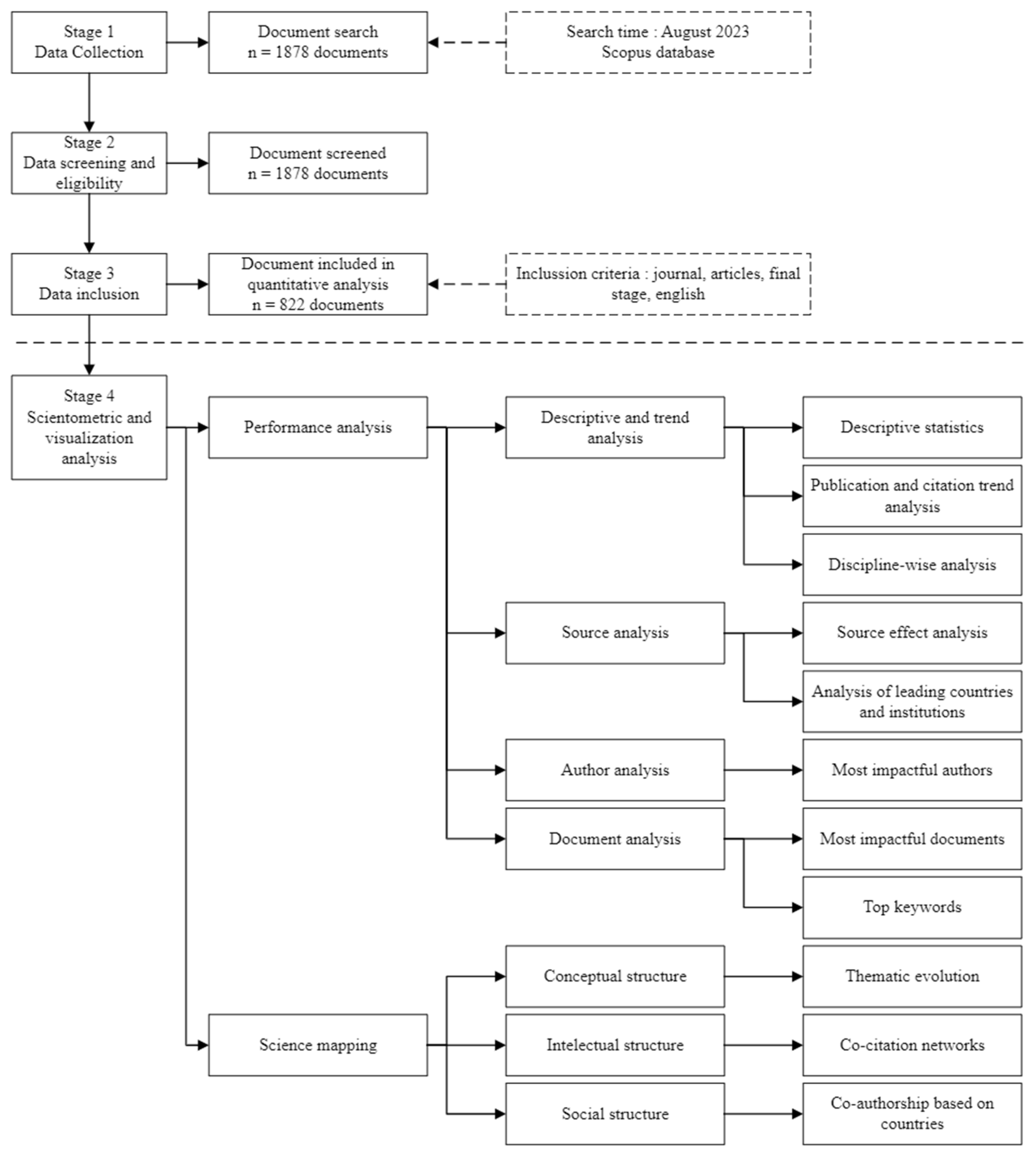
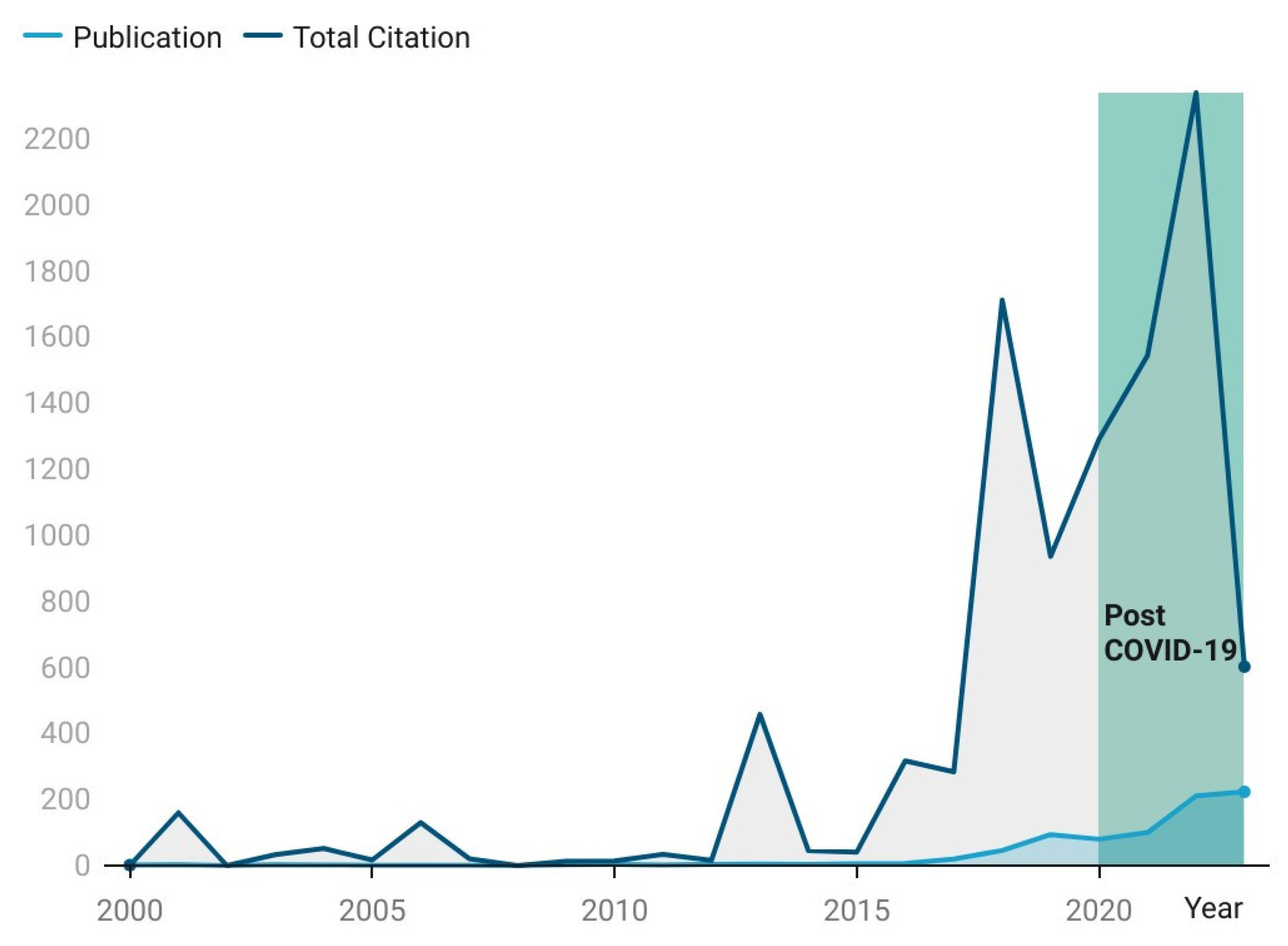
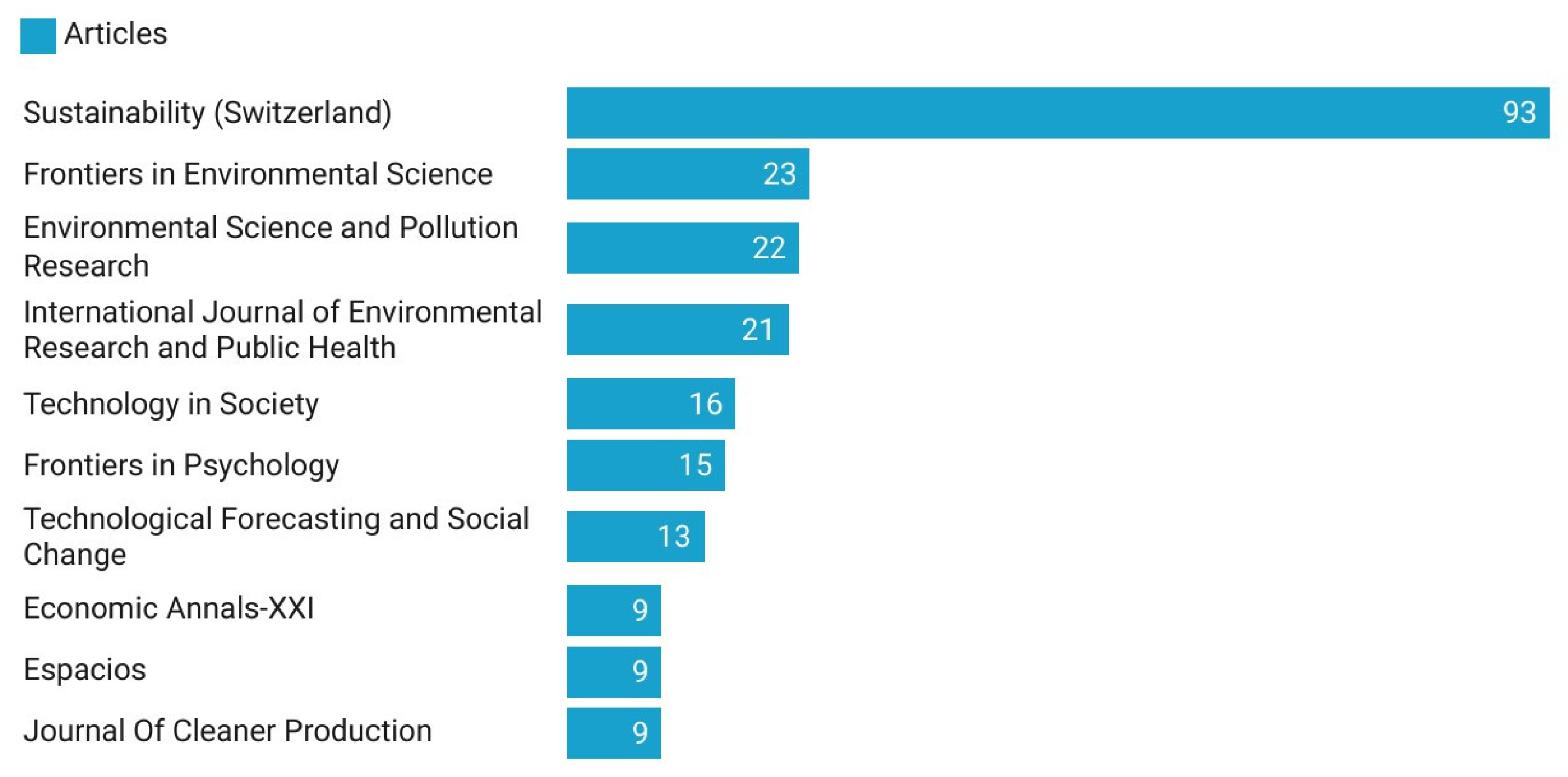
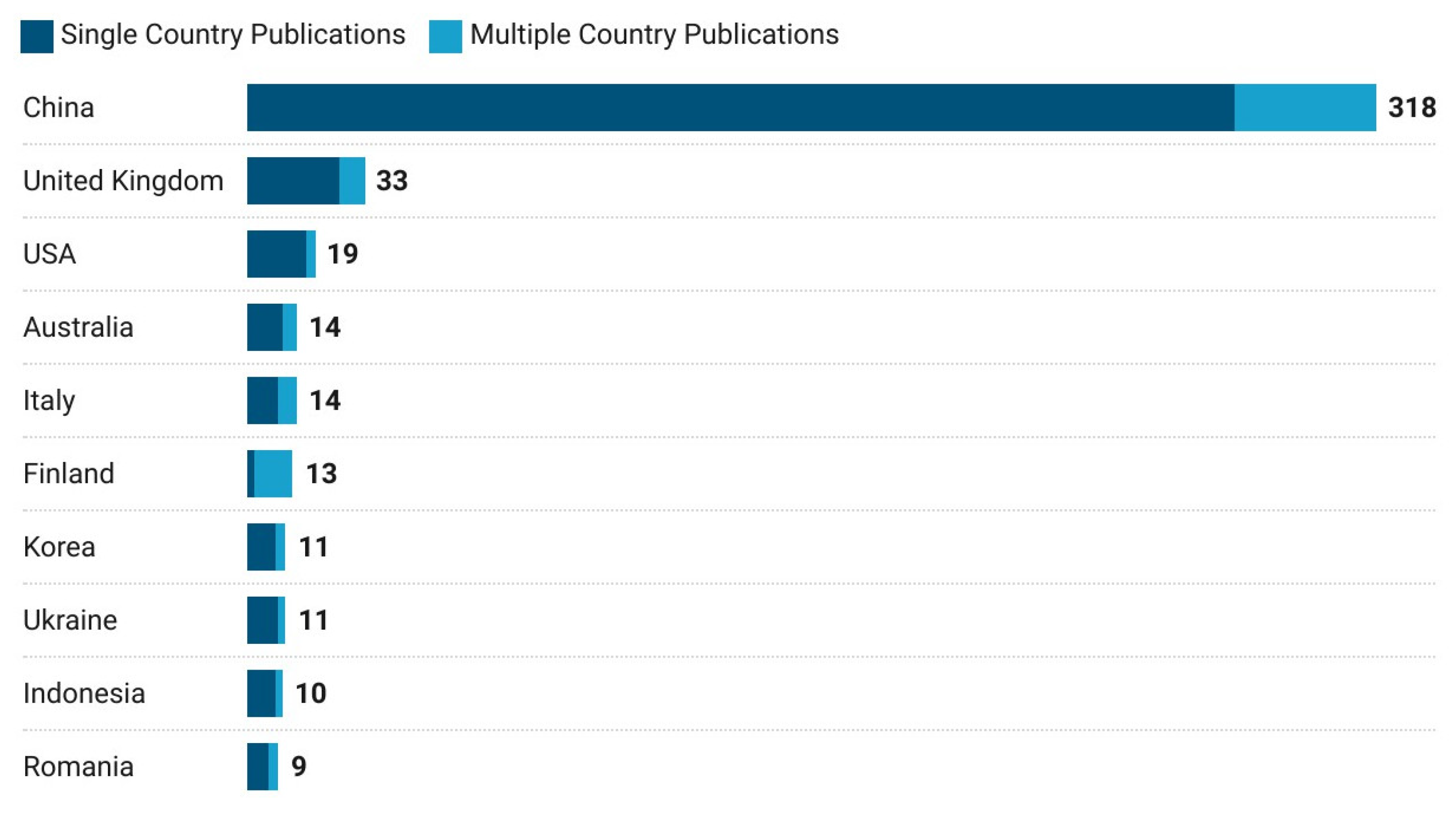
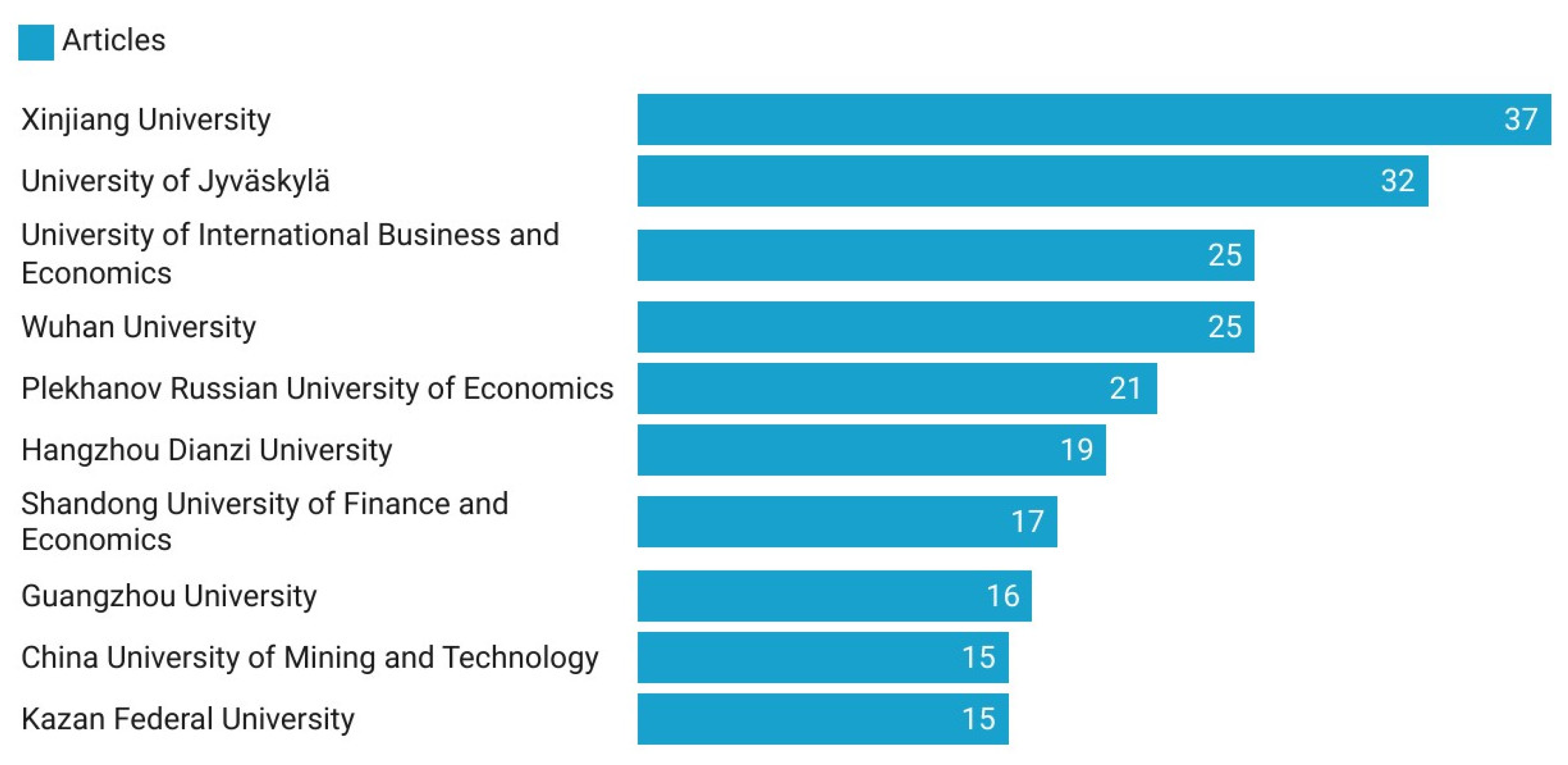
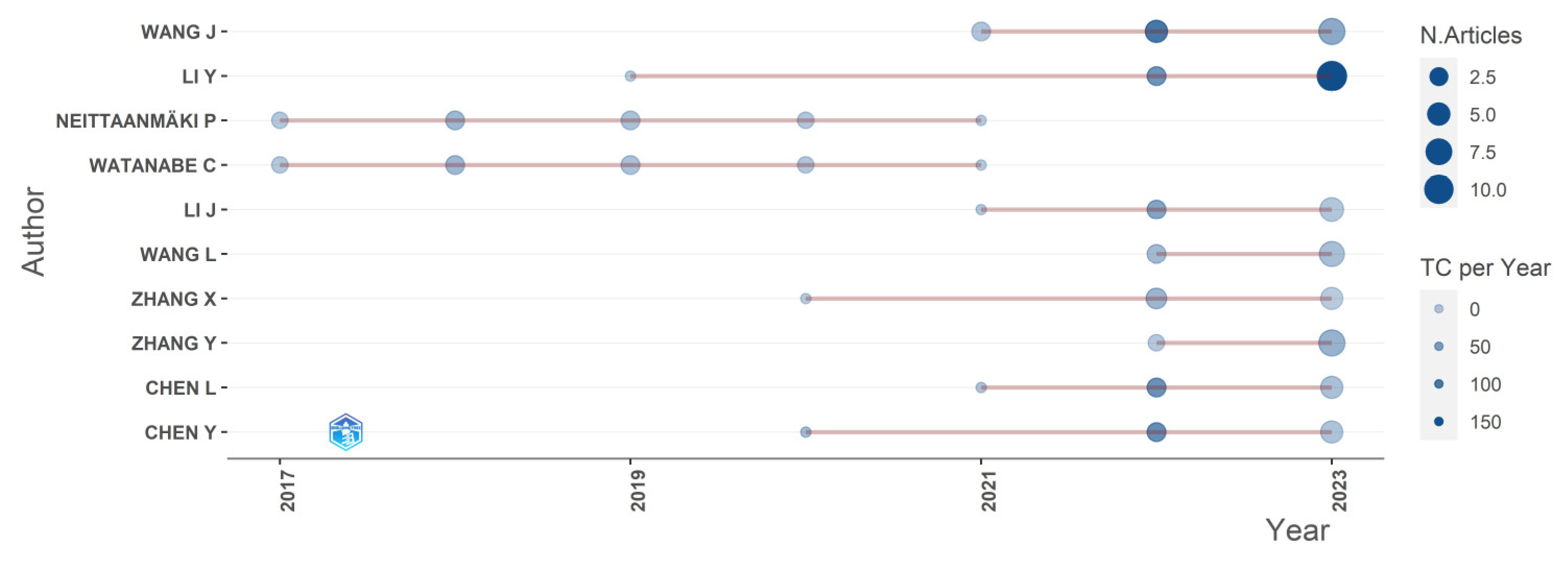
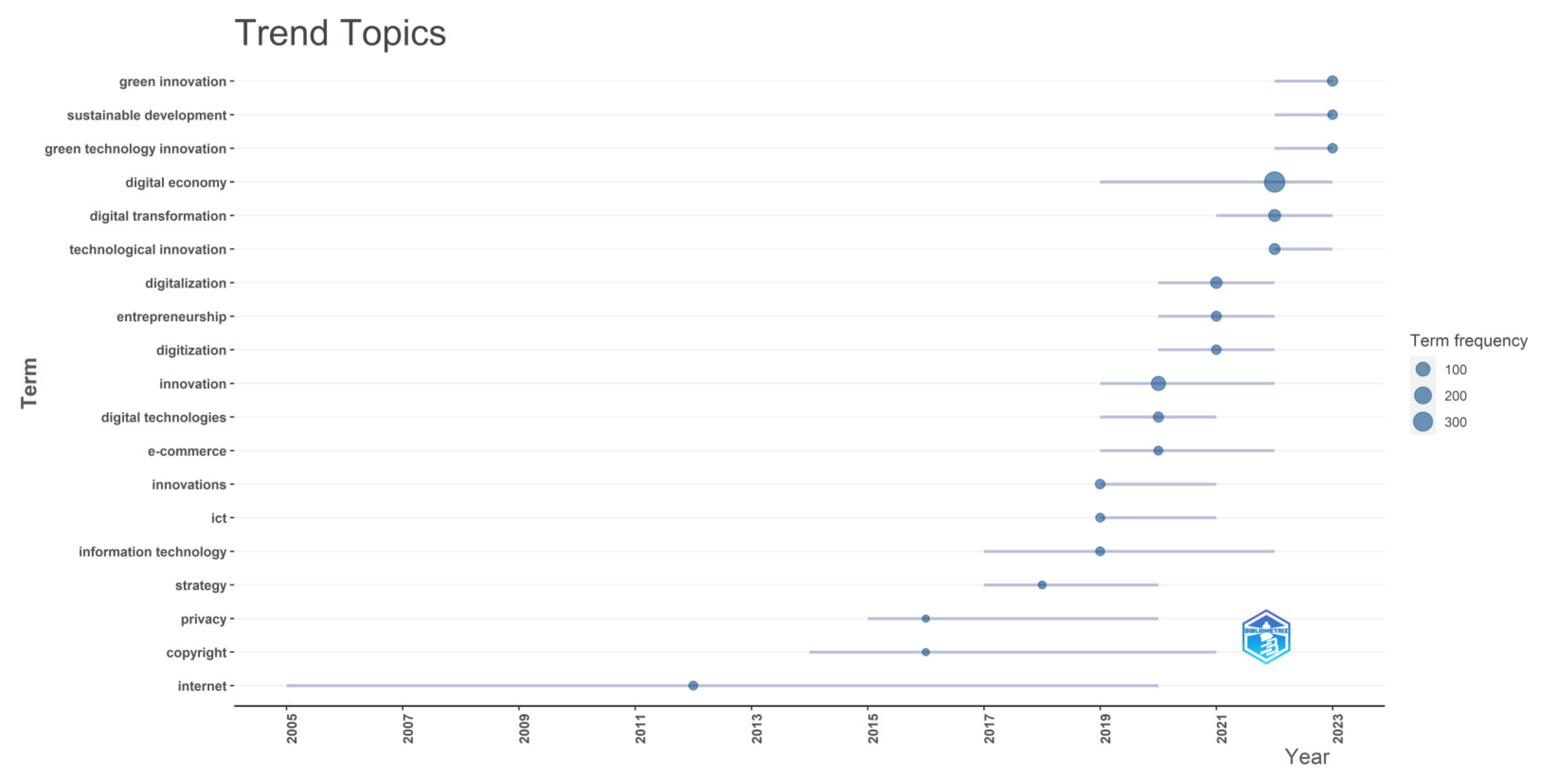
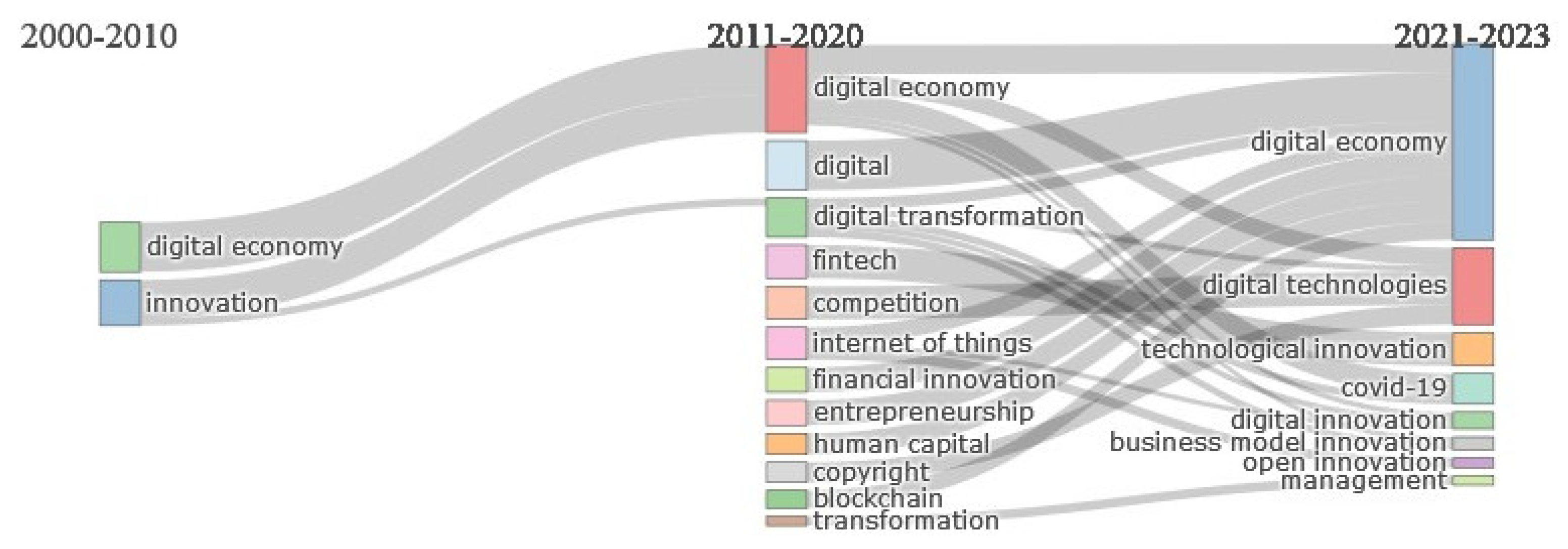
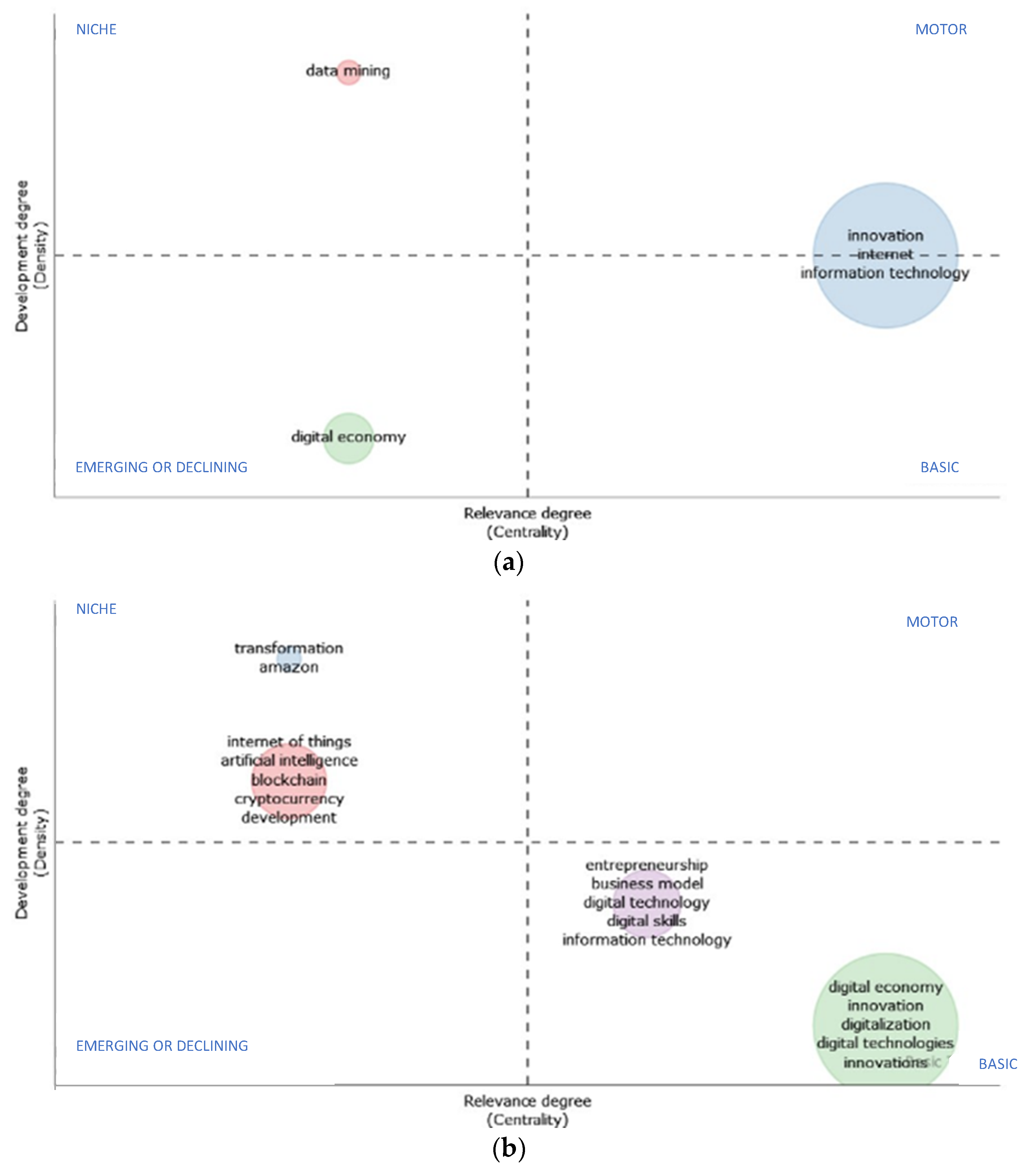

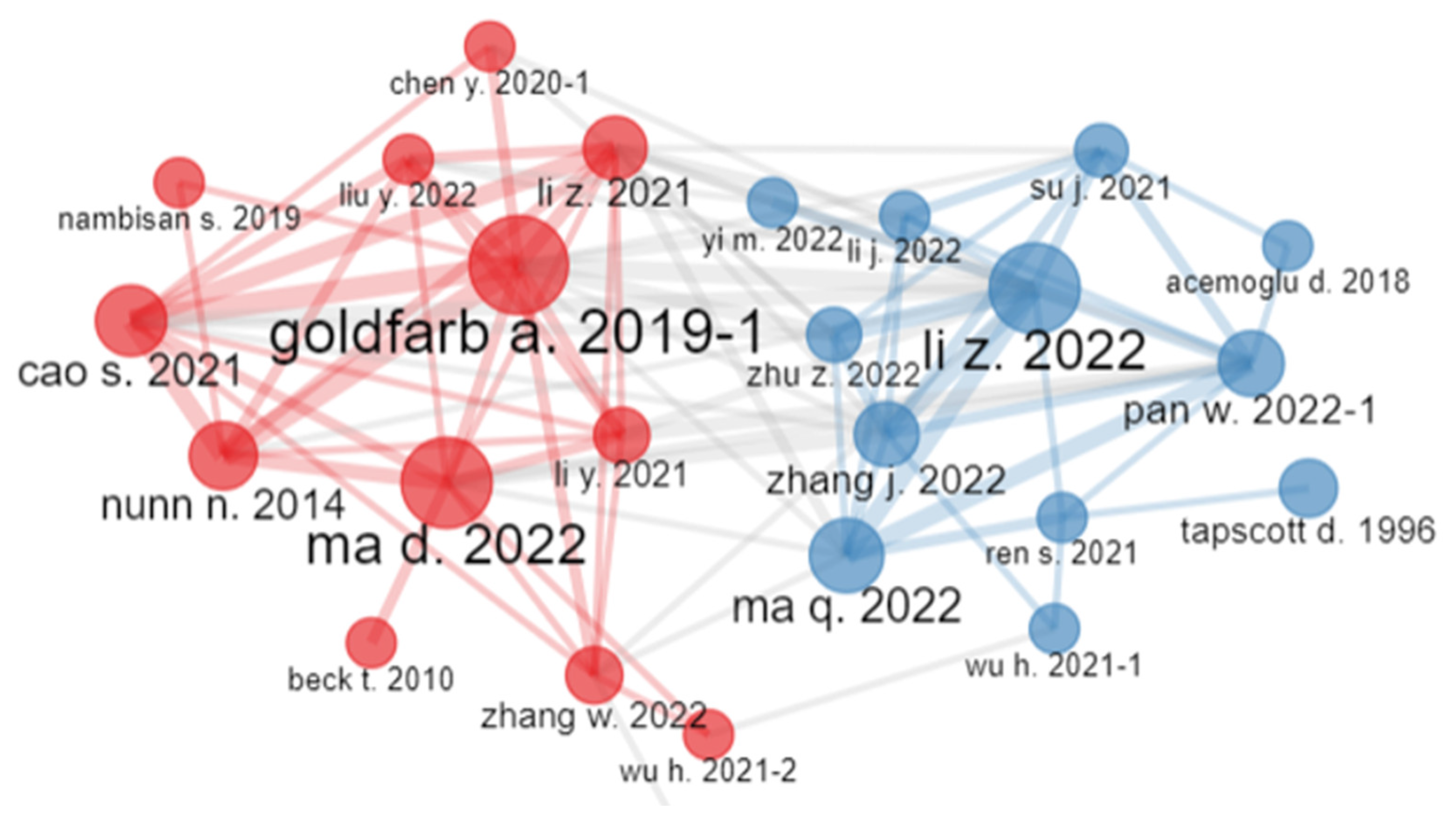
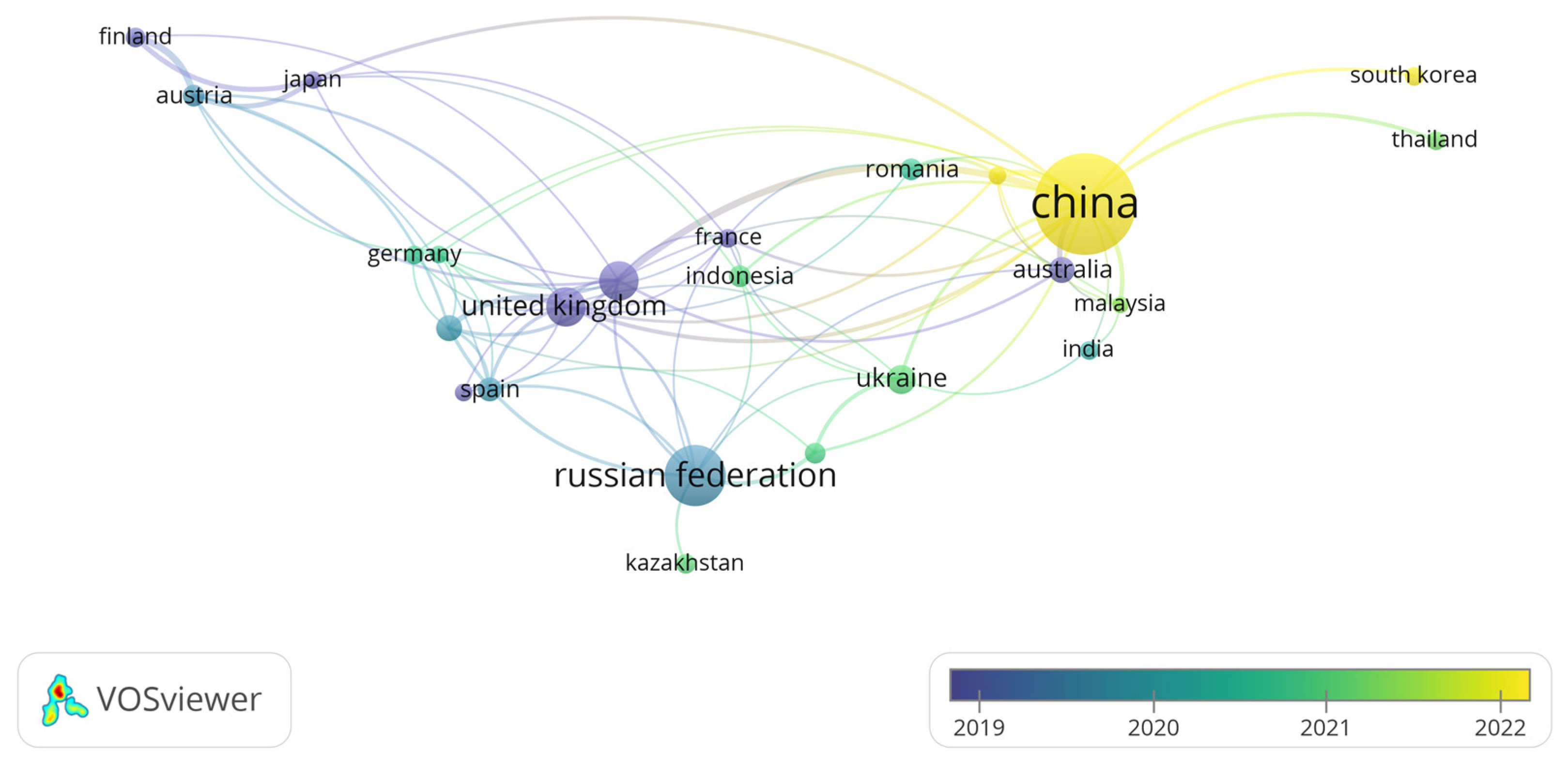
| Alpha (α) | Power (π) | Effect Size (ρ) | N |
|---|---|---|---|
| 0.05 | 0.8 | 0.1 | 614 |
| 0.05 | 0.8 | 0.3 | 64 |
| 0.05 | 0.8 | 0.5 | 21 |
| 0.01 | 0.9 | 0.1 | 1290 |
| 0.01 | 0.9 | 0.3 | 135 |
| 0.01 | 0.9 | 0.5 | 42 |
| Description | Indicator | Result |
|---|---|---|
| Main Information | Timespan | 2000:2023 |
| Sources (Journals) | 399 | |
| Documents | 822 | |
| Annual Growth Rate % | 22.75 | |
| Document Average Age | 2.41 | |
| Average citations per doc | 12.24 | |
| References | 40,332 | |
| Document Types | Article | 822 |
| Document Contents | Keywords Plus (ID) | 1712 |
| Author’s Keywords (DE) | 2606 | |
| Authors | Authors | 1953 |
| Authors of single-authored docs | 137 | |
| Author Collaboration | Single-authored docs | 142 |
| Co-Authors per Doc | 3.15 | |
| International co-authorships % | 14.84 |
| Element | h_index | g_index | m_index | Total Citation | Total Publication | First Year Publication |
|---|---|---|---|---|---|---|
| Sustainability (Switzerland) | 13 | 26 | 2.167 | 793 | 93 | 2018 |
| Technology In Society | 10 | 16 | 1.429 | 332 | 16 | 2017 |
| Technological Forecasting And Social Change | 9 | 13 | 0.391 | 342 | 13 | 2001 |
| Environmental Science And Pollution Research | 8 | 16 | 4.000 | 267 | 22 | 2022 |
| Journal Of Cleaner Production | 6 | 9 | 3.000 | 183 | 9 | 2022 |
| Economic Annals-Xxi | 5 | 9 | 0.833 | 86 | 9 | 2018 |
| International Journal Of Environmental Research And Public Health | 5 | 9 | 2.500 | 111 | 21 | 2022 |
| Journal Of Business Research | 5 | 6 | 1.667 | 426 | 6 | 2021 |
| Technovation | 5 | 5 | 0.278 | 393 | 5 | 2006 |
| Energy Economics | 4 | 4 | 1.333 | 395 | 4 | 2021 |
| Ref. | Title | Year | Total Citations | Author Keywords |
|---|---|---|---|---|
| (Teece 2018) | Profiting from innovation in the digital economy: Enabling technologies, standards, and licensing models in the wireless world | 2018 | 549 | Appropriability Complementarity General-purpose technology Licensing Platform Standards Technology policy |
| (Cardona et al. 2013) | ICT and productivity: Conclusions from the empirical literature | 2013 | 378 | Information and communication Technologies Productivity Growth accounting General-purpose technology |
| (Ren et al. 2021) | Digitalization and energy: How does internet development affect China’s energy consumption? | 2021 | 289 | Digitalization Internet development Energy consumption China |
| (Li 2020) | The digital transformation of business models in the creative industries: A holistic framework and emerging trends | 2020 | 226 | Business model Portfolio model Holistic framework Creative industry Digital technology Digital economy Transformation Innovation |
| (Scuotto et al. 2016) | Internet of Things: Applications and challenges in smart cities: a case study of IBM smart city projects | 2016 | 225 | Open innovation Internet of things Smart City IBM |
| (Soto-Acosta 2020) | COVID-19 Pandemic: Shifting digital transformation to a high-speed gear | 2020 | 179 | COVID-19 Digital Transformation Digitalization Digital economy Innovation |
| (Pan et al. 2022) | Digital economy: An innovation driver for total factor productivity | 2022 | 172 | Digital economy Total factor productivity Principal component analysis Nonlinear relationship Regional diversity |
| (Lee 2001) | An analytical framework for evaluating e-commerce business models and strategies | 2001 | 138 | Internet Economy Innovation Strategy |
| (Ma and Zhu 2022) | Innovation in emerging economies: Research on the digital economy driving high-quality green development | 2022 | 135 | Digital economy High-quality green development Smart city Spillover effects |
| (Su et al. 2006) | Linking innovative product development with customer knowledge: A data-mining approach | 2006 | 130 | Customer knowledge management Data mining Innovative product development Mobile commerce Web-based market survey |
Disclaimer/Publisher’s Note: The statements, opinions and data contained in all publications are solely those of the individual author(s) and contributor(s) and not of MDPI and/or the editor(s). MDPI and/or the editor(s) disclaim responsibility for any injury to people or property resulting from any ideas, methods, instructions or products referred to in the content. |
© 2023 by the authors. Licensee MDPI, Basel, Switzerland. This article is an open access article distributed under the terms and conditions of the Creative Commons Attribution (CC BY) license (https://creativecommons.org/licenses/by/4.0/).
Share and Cite
Hakam, L.I.; Ahman, E.; Disman, D.; Mulyadi, H.; Hakam, D.F. Exploring Trends in Innovation within Digital Economy Research: A Scientometric Analysis. Economies 2023, 11, 269. https://doi.org/10.3390/economies11110269
Hakam LI, Ahman E, Disman D, Mulyadi H, Hakam DF. Exploring Trends in Innovation within Digital Economy Research: A Scientometric Analysis. Economies. 2023; 11(11):269. https://doi.org/10.3390/economies11110269
Chicago/Turabian StyleHakam, Lazuardi Imani, Eeng Ahman, Disman Disman, Hari Mulyadi, and Dzikri Firmansyah Hakam. 2023. "Exploring Trends in Innovation within Digital Economy Research: A Scientometric Analysis" Economies 11, no. 11: 269. https://doi.org/10.3390/economies11110269






